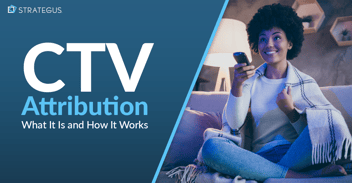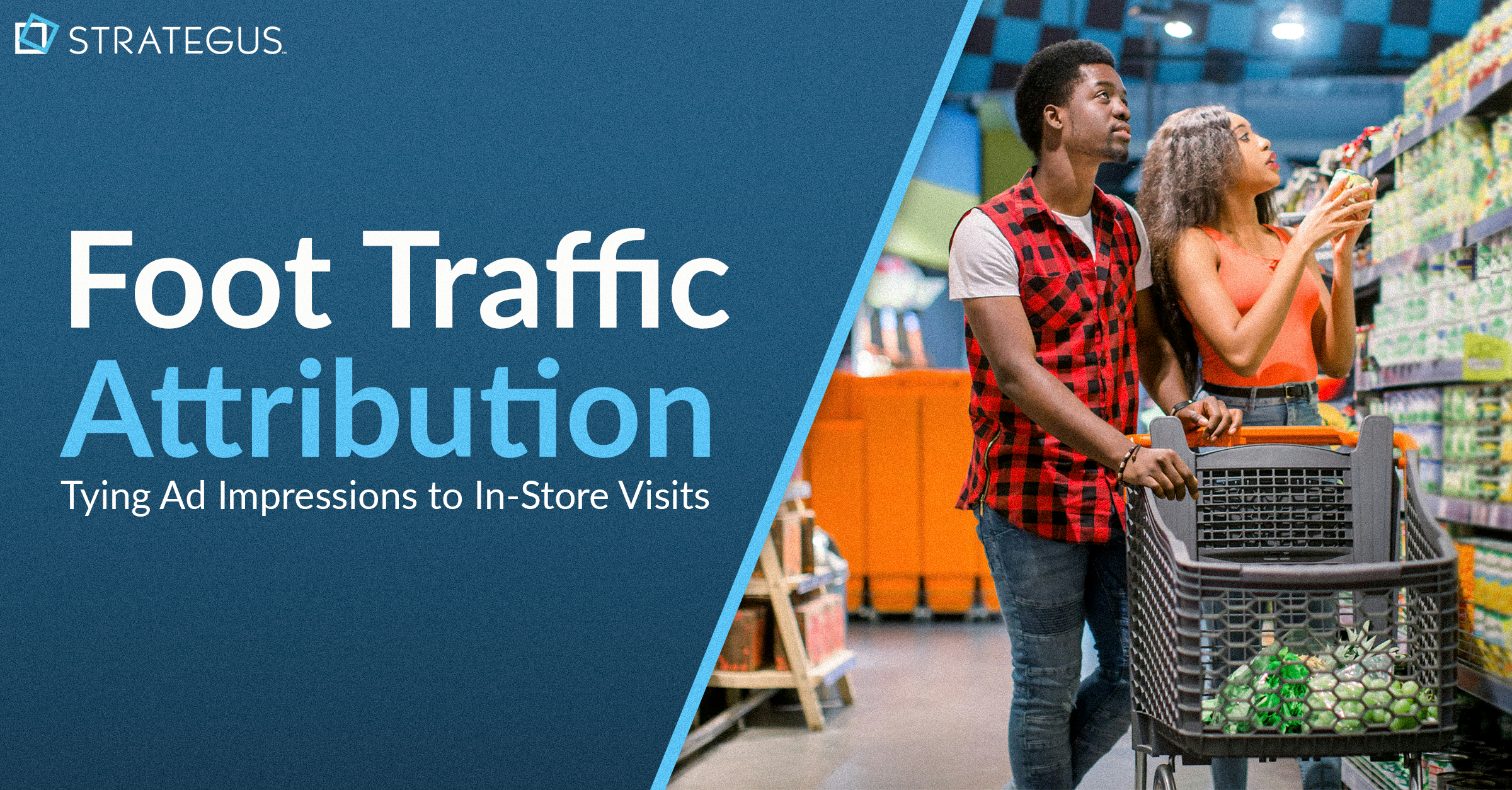- Home
- Strategus Blog
- Leveraging Data for OTT Advertising in 2022
Leveraging Data for OTT Advertising in 2022
 Andy Dixon
Andy Dixon
6 minutes read

The world of data collection changed dramatically in 2021, striking fear in the hearts of many data-reliant advertisers across the globe. That said, those changes subsequently bring a wealth of new opportunities to advertisers — if you’re willing to adapt.
Safari and Firefox have already omitted cookies to limit third-party data tracking, and Chrome plans to phase out cookies by 2023. Many mobile apps are also following suit. At the same time, Apple’s introduction of app tracking transparency (ATT) and user-friendly updates to identifiers for advertisers (IDFA) restrict the types of data advertisers can collect.
All of these updates make one thing very clear — it’s time to change how we use data. While the ways we gather and leverage data are changing, the fact remains that data collection is an integral aspect of every advertising campaign. When you understand how to leverage available data, you will see the direct impact on your campaign success.
Because they don’t rely on cookies or third-party data exclusively, OTT/ CTV advertising, digital video, and social media demand a significant proportion of ad spend. In fact, Advertiser Perceptions reports that surveyed advertisers plan to increase spending per channel by 54%, 52%, and 48%, respectively, in the next 12 months.
So, what does this all mean for advertisers entering 2022? In short, we must focus on first-party data, get creative with location-based restrictions, and leverage both data sets through OTT/CTV advertising.
First- and second-party data
First-party data is data collected directly from your audience, who provides it willingly.
There are a plethora of benefits to gathering your data firsthand , including:
- You own it
- You can do with it as you please
- There are no misinterpretations or errors because it is given by the person themself
- You receive more in-depth data
This type of data collection provides insight into a number of valuable areas, including demographics, purchase intent, browsing behavior, and much more that advertisers can use to customize a campaign. There are many ways to collect first-party data, such as:
- CRM systems
- Customer surveys, feedback, interviews, etc.
- Google Analytics
- Social Media
First-party data is the crown jewel of data collection. However, it can be challenging to collect. It doesn’t always paint a complete picture either, which is why Strategus never uses it as a sole source of data for campaigns. That’s where second-party data (i.e., someone else’s first-party data) really comes into play to ethically provide you more reliable information about your target.
Second-party data is the up-and-coming missing piece of data collection that advertisers must prioritize heading into 2022. To give you direct insight into how this amalgamation of data can come together, let’s take a look at three unique examples:
CPG Company
- Overview: A toothpaste company wants to target users who are more likely to purchase their products, and they need to learn more about their consumers’ interests.
- Problem: With limited access to first-party data, they need a reliable snapshot of their consumers’ buying habits in order to create a campaign that reaches them at the right time.
- Solution: Using second-party data collected from Kroger, Ibotta, or another second-party data source, the company can obtain a list of people who have purchased toothpaste and activate an OTT/CTV campaign against competitors.
Publisher's Clearing House
- Overview: A travel agency wants to target users actively looking for vacation packages and wants to learn more about their wants
and needs. - Problem: They don’t want to speculate using third-party data and need reliable information to target their perfect buyer.
- Solution: The travel agency turns to the Publisher’s Clearing House who has collected an array of first-party data from users signing up for various sweepstakes. In turn, they learn about consumers actively seeking vacation packages and create a campaign for them.
Shopper Data
- Overview: A car dealership wants to target users with older
vehicles who may be looking to purchase a new car. - Problem: As a smaller dealership, they are unable to build an identity graph that maps out the purchasing intent of potential customers.
- Solution: The dealership uses the DMV’s first-party data to obtain information on registered vehicles with expiring leases and creates a campaign targeted at those car owners.
Location-Based data
In addition to the prioritization of first- and second-party data, location-based data also remains paramount. However, Apple’s ATT and IDFA throw a wrench into things for many advertisers. Essentially, the updates give iPhone users greater control over location-based tracking as they only provide data after opting in.
Despite the limitations, opt-ins are becoming more and more frequent since users want their location-based apps to work correctly (weather, maps, etc.). So, despite the negativity surrounding location-based data and user preference, the fact is that location-based data remains accessible and usable in OTT/CTV advertising. Here’s how:
- Competitor Conquesting: When users opt-in to location tracking, you are able to use that effectively to track their interactions with competitors. For example, auto dealers can create OTT/CTV campaigns that target car buyers looking at competing dealerships.
- High-Value Audience: Location-based data can also be highly effective when targeting audience members who are more likely to be interested in your services. Take personal injury lawyers, for example. These firms can use location-based data to identify potential clients who recently visited an automotive collision or repair center and serve targeted messages.
- Event Targeting: With the full return to in-person shows and sporting events, event venues can also use location-based data to target attendees with messages promoting future events. For instance, if someone attended a concert, the venue can assume they are music aficionados and retarget them with advertisements promoting similar music genres in the future.
The Role of Attribution
Despite the importance of these location-based retargeting efforts, all of it may be for naught without the proper attribution tracking. Sure, you can craft what you think is the perfect retargeting campaign using location-based data, but if you don’t track the results, how do you really know your success?
Enter foot-traffic attribution. This attribution metric is imperative to
measure the success of any location-based targeting campaign. This allows you to track who viewed your ad on a CTV device and whether or not they visited your location after exposure. With this information, you can make real-time adjustments to campaign messaging and targeting to optimize your success.
OTT Advertising Next Steps
Yes, data collection trends have evolved significantly in recent years. But is that necessarily a bad thing? We think not.
The continued prioritization of first- and second-party data may seem like a hassle, but this type of collection gives you the absolute best view of your consumers’ wants and needs. In turn, you’re able to target them more directly, build genuine relationships with buyers, and ultimately create lifetime customers.
As a leader in OTT/CTV advertising, Strategus can help you build a campaign strategy that effectively utilizes second-party, location-based data, and more.
Are you ready to master your OTT/CTV strategy? Download your free guide now

Andy Dixon is a seasoned Content Writing Specialist at Strategus, renowned for his expertise in creating engaging and impactful digital content. With over a decade of experience in content creation, Andy has honed his skills in a variety of niches, ranging from technology and marketing to education.
Strategus is a managed services connected TV(CTV) advertising agency with over 60,000+ campaigns delivered. Find out how our experts can extend your team and drive the result that matter most.
Talk to an Expert
Table of Contents
Seeking a Custom CTV Strategy That Delivers?
What to read next

Third-Party Data Targeting for CTV: Benefits & Tactics
Third-party data. It’s a term that’s thrown around, and yet few take the time to detail its pros and cons — much less strategies for using...
7 minutes read

First-Party Data Targeting: Benefits and Tactics for CTV Advertising
First-party data is the information that companies collect directly from their customers rather than through intermediaries. Advertisers use this...
10 minutes read

Foot-Traffic Attribution: Tying Ad Impressions to In-Store Visits
The marketing funnel has changed. Today’s shoppers often begin researching products from the comfort of their homes and don’t set foot into a store...
8 minutes read

CTV Attribution: What It Is and How It Works
Connected TV (CTV) viewing is on the rise — and that’s good news for marketers. Not only can CTV ads be precisely targeted to individual households,...
9 minutes read
















